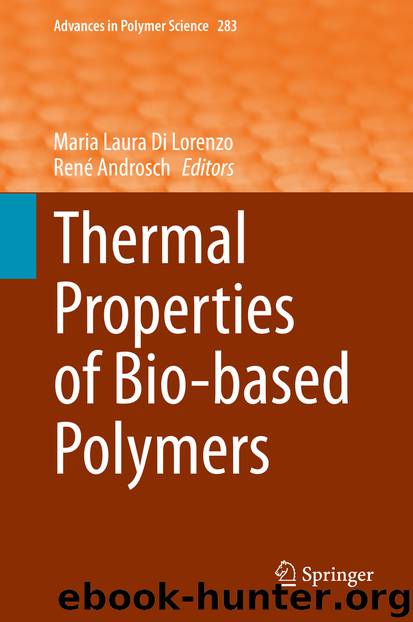Thermal Properties of Bio-based Polymers by Maria Laura Di Lorenzo & René Androsch

Author:Maria Laura Di Lorenzo & René Androsch
Language: eng
Format: epub
ISBN: 9783030399627
Publisher: Springer International Publishing
5 Melting of PHB Crystals
Semicrystalline PHB heated at typical DSC rates (5–100 K/min) often displays multiple melting behaviors. The occurrence of multiple melting events may be caused by presence of more than one crystal modification, molecular-weight segregation that accompanies crystallization, different crystal morphologies/size, orientation effects, or reorganization processes that occur during heating [96]. In the case of PHB, it was shown that multiple melting arises from partial melting and recrystallization upon heating, with crystal perfection occurring not via chain sliding diffusion but by partial melting and subsequent melt recrystallization [12, 97–99].
Small- and wide-angle X-ray scattering (SAXS and WAXS) analyses of PHB single crystal showed that the lamellar thickness increases discontinuously upon heating [97, 99]. This is illustrated in Fig. 13, which shows a jump in lamellar thickness around 120–125°C, with the exact discontinuity temperature depending on molar mass as well as on the initial morphology. The lattice dimensions of the orthorhombic α-modification measured during heating at the same rate, presented in Fig. 14a, increase gradually up to about 120°C (region I), slightly reduce at temperatures between 120 and 135°C (region II), and finally increase or remain constant (region III) above 135°C. Region II parallels the transition region of lamellar thickening shown in Fig. 13. The crystal fraction, shown in Fig. 14b, starts to slightly decrease from 115–120°C, to reach a minimum around 125°C. Further heating leads to increase of the crystallinity up to 135°C, which finally drastically decreases due to crystal melting. The DSC heat flow rate plot is in line with the structural changes observed by SAXS and WAXS: the first decrease of the crystallinity from 115 to 125°C, which corresponds to the lower side of region II, occurs in the range of the lower endotherm, indicating that the single crystals melt. The next increase (high-temperature side of region II) is associated with recrystallization, causing an exothermic peak at 136.5°C in the DSC curve. At this temperature, the crystal fraction recovers completely, suggesting that all original crystals completely transform to thicker ones in region II. The parallel evolution of heat flow rate and lattice dimensions in Fig. 14 indicates that the discontinuous increase in thickness of PHB single crystals upon heating is not caused by chain sliding diffusion but by partial melting and subsequent recrystallization [97, 98].
Fig. 13Temperature dependence of the lamellar thickness of PHB single crystals mats isothermally grown in a 0.05 w/v% 1-octanol solution at 60°C for 24 h, upon heating at 10 K min−1. Adapted from Ref. [97], with permission from Wiley
Download
This site does not store any files on its server. We only index and link to content provided by other sites. Please contact the content providers to delete copyright contents if any and email us, we'll remove relevant links or contents immediately.
| Automotive | Engineering |
| Transportation |
Whiskies Galore by Ian Buxton(41524)
Introduction to Aircraft Design (Cambridge Aerospace Series) by John P. Fielding(32883)
Small Unmanned Fixed-wing Aircraft Design by Andrew J. Keane Andras Sobester James P. Scanlan & András Sóbester & James P. Scanlan(32569)
Craft Beer for the Homebrewer by Michael Agnew(17927)
Turbulence by E. J. Noyes(7690)
The Complete Stick Figure Physics Tutorials by Allen Sarah(7135)
Kaplan MCAT General Chemistry Review by Kaplan(6588)
The Thirst by Nesbo Jo(6432)
Bad Blood by John Carreyrou(6270)
Modelling of Convective Heat and Mass Transfer in Rotating Flows by Igor V. Shevchuk(6219)
Learning SQL by Alan Beaulieu(6029)
Weapons of Math Destruction by Cathy O'Neil(5820)
Man-made Catastrophes and Risk Information Concealment by Dmitry Chernov & Didier Sornette(5641)
Digital Minimalism by Cal Newport;(5384)
Life 3.0: Being Human in the Age of Artificial Intelligence by Tegmark Max(5181)
iGen by Jean M. Twenge(5151)
Secrets of Antigravity Propulsion: Tesla, UFOs, and Classified Aerospace Technology by Ph.D. Paul A. Laviolette(4974)
Design of Trajectory Optimization Approach for Space Maneuver Vehicle Skip Entry Problems by Runqi Chai & Al Savvaris & Antonios Tsourdos & Senchun Chai(4837)
Electronic Devices & Circuits by Jacob Millman & Christos C. Halkias(4739)
